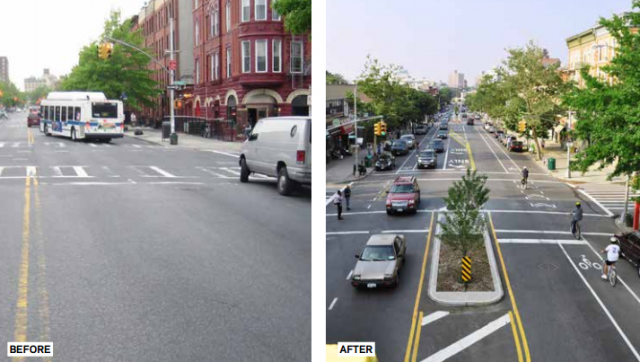This is a guest post by Kiel Johnson.
A specter is haunting our cities — the specter of street life!
Our streets make up the vast majority of our public space in cities. How these spaces are designed have profound impacts on how we think about communities and the policies we create. Janette Sadik-Khan’s “Streetfight: Handbook for an Urban Revolution” is a necessary chronicle and persuasive argument for giving street space back to people. She writes “streets are the social, political, and commercial arteries of cities … These are the spaces where life and history happen.”
Last week, I presented to a group of business leaders in the Lloyd District, most of whom commute by car from the suburbs. I was talking about the Better Broadway project that will open one auto lane of Broadway up for businesses and people for one week next month.
To make my case, I referenced a report that Sadik-Khan’s New York City Department of Transportation put together using tax receipt data to compare streets that had added bike lanes and pedestrian plazas and reduced speeding by better coordinating the space dedicated to cars. In most cases, the streets that had been transformed saw more business.
Surprisingly, at the end of my presentation no one screamed that I was possessed by the devil, hell-bent on destroying everything good in the world. Through this book and her work, Sadik-Khan has given street fighters the weapons to transform our streets: data and success stories. That is the strength of this radical and revolutionary book.
Advertisement
Sadik-Khan’s well-written book has much to offer to the way people think about and design streets. She writes:
Cities must adopt a more inclusive and human approach to reshaping the urban realm and rebuilding it quickly to human scale, driven by a robust community process, but committed to delivering projects and not paralyzing them. Reversing the atrophy afflicting our city streets requires a change-based urbanism that creates short-term results – results that can create new expectations and demand for more projects.
If we want a more inclusive community with policies based on compassion instead of fear, we need to build public space that fosters compassionate interactions, not walls of freeways that encourage solitude.
“Streetfight” weaves the narrative through Sadik-Khan’s experiences as NY Transportation Commissioner from 2007 to 2013. Each tale of urban renewal begins with the forces fighting “any change to the urban context” but ends with their defeat at the hands of strong leadership and enlightening data.
In the New York Post’s review of “Streetfight,” titled “How Janette Sadik-Khan Ruined Our Streets,” frequent Sadik-Khan critic Steve Cuozzo unknowingly makes the case for the book he does not endorse:
Our eyes tell a different story. … In nearly every case, just about the only riders most times of day are food delivery people. While a boon to Upper East Siders who might have a shorter wait for General Tso’s chicken, it spells slower progress for the zillion cars, trucks and buses trying to inch their way uptown.
Some people might never be convinced, but this book once and for all eliminates the argument that Steve Cuozzo’s eyes are the best metrics for urban planning.
While the book is full of acknowledgements and “thank yous,” Sadik-Khan’s recollection of the then-Portland-based Alta Bicycle Share is much less rosy. She says it was an “ordeal to keep the program from collapsing and rescue it from the self-inflicted wounds of its own management.” From a failure to secure funding to technology disasters, the rollout of New York’s bike share faced repeated delays. She sums up the experience by saying “they were either out of touch with the truth or had no concept of how to conduct the public’s business in New York City.” Ouch.
While there is a lot of inspiration to be drawn from this book, by the end your biggest hope is that Sadik-Khan will become your city’s next transportation director. The amount of resistance that had to be overcome to create change seems daunting. I frequently fantasize about what Portland’s Transportation Director Leah Treat’s book would be called. Perhaps “Give Me Street Fee Or Give Me Death”? Or “Portland: A Once Notable City That Removed A Highway A Long Time Ago”? I hope that this book does not sit on the same shelf as the Portland Bike Plan.
Sadik-Khan’s victories show that success can only come by taking big risks. The only things we have to lose are ugly, expensive parking lots. We have a world to win!
—Kiel Johnson is the owner of Go By Bike, the bike shop and free valet operating in the South Waterfront neighborhood.





